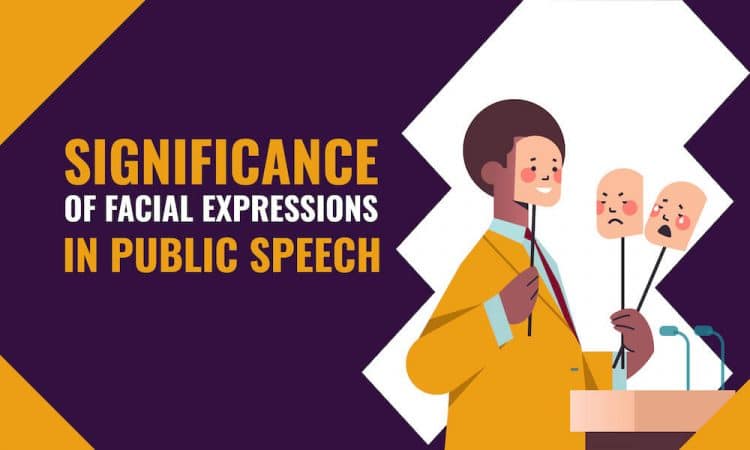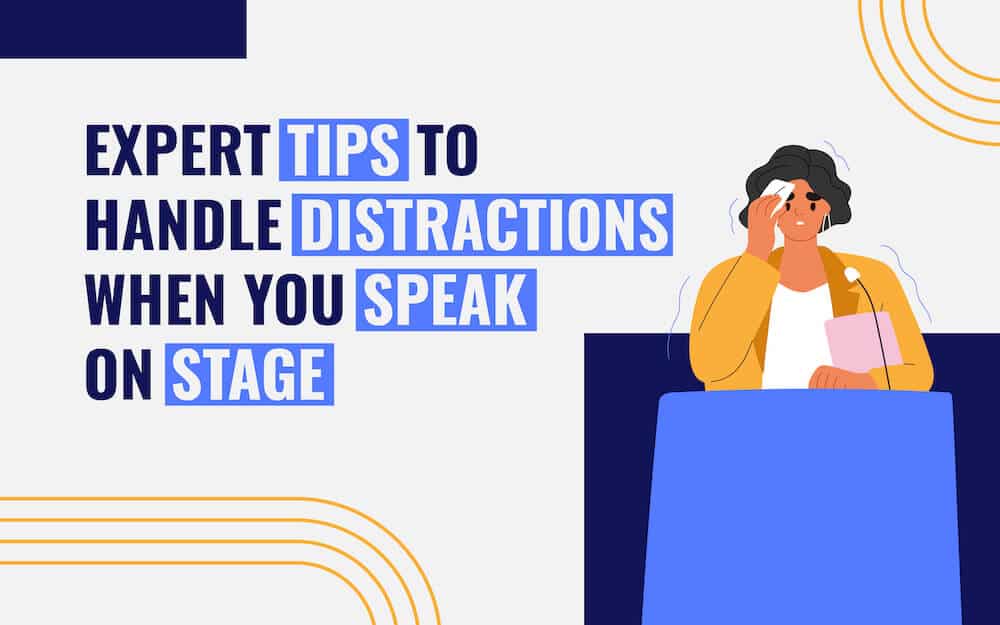
Are you one of those who think communication happens only through words?
Or maybe that nonverbal communication (facial expressions) isn’t as clear or effective as verbal communication?
Well, we urge you to rethink that. Close your eyes and imagine a face in the following expressions – upward arched lips, frowned eyebrows, poker face, and droopy eyes.
Hasn’t that face communicated to you already without any single exchange of words? You can pinpoint through the facial expressions that the supposed person is happy, tense, blank/serious, sad/tired, respectively.
That’s how prominent your expressions are when you talk to people.
How significant is it in public speaking and presentations? Well, imagine telling people how grim our environmental situation is with a joyous face. You got the point.
It is very important to be mindful of facial expressions in public speaking and to make sure that it’s coherent with your message throughout. The article details the role of facial expressions in public speaking and the tips to correct that.
Read on to know more.
Importance of Facial Expressions in Public Speaking
Facial expressions can communicate various emotions, moods, and attitudes. For instance, a presenter can communicate if he is tired, confused, confident, disinterested, bored, shy, smug, etc., by choosing certain combinations of expressions.
A slack face with no expression can give the impression that you are bored with your speech, even if you aren’t, which can make the audience lose interest, too. That’s why going for favorable expressions is so important. Let’s go through some of the other reasons.
- It will set the tone for your speech.
- It is a powerful tool to enhance your speech.
- It can help you express yourself (personality, thoughts, emotions, intentions, feelings, etc.), thus letting you build rapport with people and engage them.
- Right facial expressions can influence the way people perceive you. A smiling face can indicate a warm and friendly personality; similarly, a frowning expression could exhibit doubt.
- Facial expressions are a great tool to support, strengthen, complement, contradict, or reinforce your verbal message. For instance, raised eyebrows could be used to add emphasis or sarcasm to your words, or a solemn face to denote the gravity and sincerity of a situation.
Tips to Use Facial Expressions Effectively in Speech
There are three factors that every speaker needs to consider to make effective use of expressions in their speech.
1. Appropriateness
It’s important to avoid cue incongruence, i.e., the verbal and non-verbal cues say different things. Your expressions should be appropriate according to the content of your speech. It should match the tone and context of your talk.
For instance, if you want to draw attention to the failure of a new product, a happy face would be inappropriate for that. Inappropriate facial expressions can confuse people regarding the message of your speech.
2. Consistency
Your expressions and body language should be consistent and in alignment with your message throughout your speech.
Imagine you start with a sad and solemn (relevant and appropriate) expression when you start your talk regarding the environmental crisis. But midway through the grim statistics, your expressions change into that of amusement and fun. Further, down the talk, you suggest corrections with a hopeless and nonchalant face. Well, you get the point. It will not only confuse people but show you as an unreliable speaker as well.
3. Variety
Don’t rely on the same facial expression throughout your speech. You can’t go ahead with a smiling face all through or a solemn expression, even if the topic is serious and demands that. There has to be a variety to avoid looking monotonous and boring.
Also, going for the same face the whole time will also diminish the impact of that expression to convey your message. For instance, if you keep smiling, people won’t be able to identify the meaning of your smile when you want to use it to forge a connection or show warmth (in a situation).
Tips to Ace Expressions in Your Speech
The impact you generate as a speaker stands on both verbal and non-verbal communication. You might be a pro with your content and words, but do you feel the same about your non-verbal communication?
Let’s go through some tips that can help you have better control over your facial expressions.
- Be authentic and real with the expressions. Anything that doesn’t fit your personality and message will appear out of place, making you look odd.
- To break the ice and set a positive tone, briefly smile at everyone before you start speaking. Be mindful of grimacing, a tense jaw, or showing a lot of teeth when smiling.
- Your emotional connection to the words will reflect on your face as well. Experience your message inwardly, and you will have no trouble with the right facial expressions.
- Be engaging and attentive, using your gaze to connect with your audience.
- Avoid touching your nose, mouth, or chin during the speech. It is considered a sign of insecurity and can be perceived negatively by people.
How to Enhance Your Expression Skills?
Similar to gestures, expressions enhance and reinforce your speech. When you make a mistake, it is generally the twitching or blank expression that gives you away. It immediately comes to our faces, and the audience can see it.
The following tips will help you improve and hone your facial expressions.
1. Record Yourself
Recording yourself and watching later is one of the most effective strategies to correct a lot of things in your speaking skill set. Give your presentation or speech in front of the camera and assess yourself later for any flaws and corrections.
You can check whether your expressions are monotonous or vibrant enough and if they align with the message of your presentation and body language.
2. Learn from Others
You can watch your friends and colleagues and even other presenters (online or offline) to assess their expressions and how they use them to enhance their message.
Google the best orators and presenters and see how they use this nonverbal communication to their advantage and what makes them so thriving. Learn from them and steer clear of repeating the same mistakes.
3. Take Constructive Feedback
Let your friends or family members watch your speech while you rehearse. Ask them for their feedback. Having multiple eyes assess you can bring to your notice a lot of things you might have missed. Ask them to analyze your expressions and how they can affect the audience.
Take honest and constructive feedback and correct it wherever needed. For instance, you might get suggestions to change certain expressions, work on your eye contact more, and increase or decrease the intensity and gravity of your expressions, etc., to amplify your message.
4. Experiment and Practice
Practice as much as you can and experiment with different facial expressions to see what works best. See how changing the expressions changes the tone, intensity, and gravity of your message.
Work in front of different audiences to assess yourself better each time. Practicing well beforehand (in front of the mirror or people) will also help you look natural later. The eye contact will be natural and effortless, and your facial expressions will not look forced, monotonous, or robotic.
What Your Facial Expressions Could Denote?
Let’s go through some common facial expressions and what they could mean in your speech.
a). Smile
You can use it to convey gratitude, happiness, approval, openness, and warmth. It will help you forge a connection with people, create a positive environment, and ease the tension.
b). Frown
You can use the expression to convey discontentment, disagreement, anger, etc. It can be further used to show concern, sympathy, emphasis, confront, or question people.
c). Raising the Eyebrows
The subtle expression can help you convey curiosity, skepticism, and astonishment. You can also use it to invite participation from people, add humor or irony to your words, or signal a change of topic.
d). Nodding
Nodding is to show agreement, acknowledgment, support, and encouragement to people. Through nodding, you can let everyone know you are paying attention to what they are saying, making them feel heard and respected.
You can also use it to indicate and convey the continuation or conclusion of your speech.
Pay attention to people’s expressions as well. It will help you respond appropriately and see who is actually connecting with you and who isn’t.
In a Nutshell
Proper facial expressions will bring your speech to life and help you communicate emotions and enthusiasm for your talk. Like speech, we use expressions without conscious thought in our everyday interactions.
However, standing in front of a crowd can turn even the most expressive of us into poker faces.
The tips are designed to help you ace this aspect of non-verbal communication and use it to deliver an impeccable and engaging speech.
Monitor yourself to become aware of your typical delivery habits and assess how expressive/inexpressive your face is. With consistent practice, you can consciously control, improve upon, and master facial expressions and eye contact to become an effortless and effective presenter.



